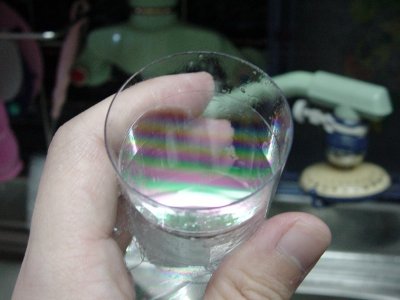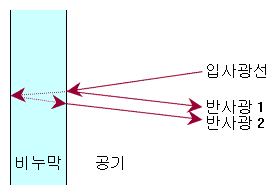Interference patterns seen in thin films
If a thin oil film is floating on the water, you will see a beautiful pattern appear on the oil film.
This is because the two waves interfere with each other. One wave is reflected from the surface, and the other is reflected from the inside.

Rainbow colors are common in soap bubbles. The difference from the rainbow in the sky is that the bands of color tend to repeat.
The principle of the interference pattern generated
As shown in the figure below, two-branched reflections occur when one strand of light enters the soap film.

If the two phases can merge, it looks bright (Constructive interference).

If the two phases cancel each other out, it looks dark (Destructive interference).

Visible light has different wavelengths depending on the color of light. Red light has a wavelength of about 600 nm. Blue light has a wavelength of about 450 nm. Depending on the film's thickness, the wavelength at which reinforcement interference occurs will continue to vary. This is why thin films look colorful.
The light intensity of the interference pattern
Bright condition \( 2nL\, =\, (m+\frac { 1 }{ 2 } )\lambda \)
Dark conditions \( 2nL\, =\, m\lambda \)
m = 0, 1, 2, ... A value indicating how many times the thickness of a bubble is the wavelength of light
n: Refractive index of soapy water
L: Bubble thickness (nm)
λ: Wavelength of light (nm)